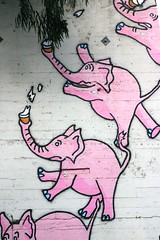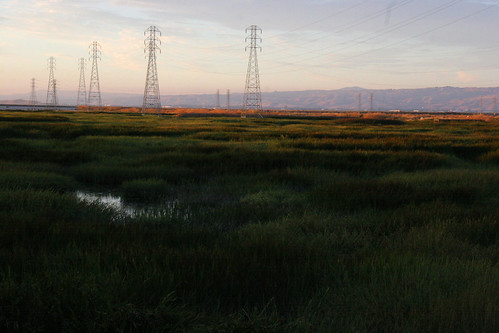
Saturday, October 25, 2008
Wednesday, October 22, 2008
Inspired

I just started my new gig so the posting has been a little slow. I've recently seen a couple of inspiring photographers that are worth noting. The first is Joel Sartore, a photographer who's name you probably don't know, but who's pictures you probably do. At Close Range with National Geographic is a short documentary on this heroic photographer.

Also inspiring is Callie Shell's series for the Digital Journalist on Senator Obama before and during his campaign for the the Presidency. Callie not only has a sense for the moments and emotions, but also an eye for the shot. Light, distance, and timing are the pillars of her amazing work on our hopeful future president.
Tuesday, October 14, 2008
Eighty Eight and Sunny

First decent ride on the pista in ages. I only wanted to coast once. Delivering flyers and posters for the Super Market Street Sweep was a great reason to enjoy the weather.
88.0 °F / 31.1 °C
48.7 °F / 9.3 °C
Met Hamish today and saw Niloc and Melissa. Seth, Brad, Sumeet, and Aus took my ten dollars.
Super Market Street Sweep
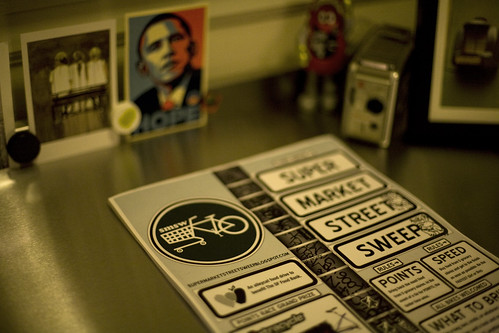
I'm helping organize the Super Market Street Sweep again this year. If you're going to be in SF this December and want to support the SF Food Bank on two wheels, you should come out.
The rules and format for this year's SWEEP will remain the same as before. There will be a SPEED race and a POINTS race.
For the SPEED race, be the FASTEST Boy or GIRL to bring back groceries from 5 supermarkets. Prizes for road bikes and fixed!
For the POINTS race, bring back the most groceries you possibly can from 5 supermarkets. Certain food items will earn you BONUS POINTS. This year's overall top POINTS RACE winner will get a special prize from XTRACYCLE! They're donating a COMPLETE FREE RADICAL KIT that includes installation! Win this and you can haul your groceries with your bike for life (and win future Sweeps!)
For more information and a complete list of sponsors check out the Super Market Street Sweep Blog.
Friday, October 10, 2008
First Amendment, Slander, and Campaign Politics
Like many of us who are following the campaign for the White House, I have keenly followed the attacks and the responses by each camp. During this campaign, unfortunately like most others, I've heard a number of claims being made, bad facts, slanted truths, and outright lies aimed directly at Senator Obama, his associations, his record, and his intentions.
While most of this is campaign "business as usual" I can't help but wonder how this squares up with the first amendment and the laws regarding slander. Wikipedia's entry defines slander, "In law, defamation (also called calumny, libel, slander, and vilification) is the communication of a statement that makes a false claim, expressly stated or implied to be factual, that may give an individual, business, product, group, government or nation a negative image."
Let's take McCain's recent attack on Obama claiming a connection to famed 1960's Weather Underground radical Bill Ayer. The allegations that Obama "ran a radical 'education' foundation" with Ayer have been found to be misleading and false. While hateful speech can be protected by our First Amendment, outright lies that attempt to smear another individual seem to fall squarely in the realm of slander.
So how do campaigns get away with this? I've done a bit a research and have failed to find any lawsuits brought against candidates seeking the office of president for smear tactics. While a lawsuit is probably the worst campaign strategy, it would be interesting to see a lawsuit post election day. I suppose at that point the winner has too much to lose and the loser has already lost the election.
Meanwhile the McCain campaign attempts to quell the raging fires it has lit over the past week. "If you want a fight, we will fight," McCain said. "But we will be respectful. I admire Sen. Obama and his accomplishments." I am less angry as I am fearful at the ease in which McCain's base has taken his lies into a place of violent fervor.
Perhaps at the end of the day, the public has become numb to the dishonesty of American politics. I, however, would love to see a little justice served.
While most of this is campaign "business as usual" I can't help but wonder how this squares up with the first amendment and the laws regarding slander. Wikipedia's entry defines slander, "In law, defamation (also called calumny, libel, slander, and vilification) is the communication of a statement that makes a false claim, expressly stated or implied to be factual, that may give an individual, business, product, group, government or nation a negative image."
Let's take McCain's recent attack on Obama claiming a connection to famed 1960's Weather Underground radical Bill Ayer. The allegations that Obama "ran a radical 'education' foundation" with Ayer have been found to be misleading and false. While hateful speech can be protected by our First Amendment, outright lies that attempt to smear another individual seem to fall squarely in the realm of slander.
So how do campaigns get away with this? I've done a bit a research and have failed to find any lawsuits brought against candidates seeking the office of president for smear tactics. While a lawsuit is probably the worst campaign strategy, it would be interesting to see a lawsuit post election day. I suppose at that point the winner has too much to lose and the loser has already lost the election.
Meanwhile the McCain campaign attempts to quell the raging fires it has lit over the past week. "If you want a fight, we will fight," McCain said. "But we will be respectful. I admire Sen. Obama and his accomplishments." I am less angry as I am fearful at the ease in which McCain's base has taken his lies into a place of violent fervor.
Perhaps at the end of the day, the public has become numb to the dishonesty of American politics. I, however, would love to see a little justice served.
Tuesday, October 7, 2008
Unlikely Tourist in Soweto Part IV
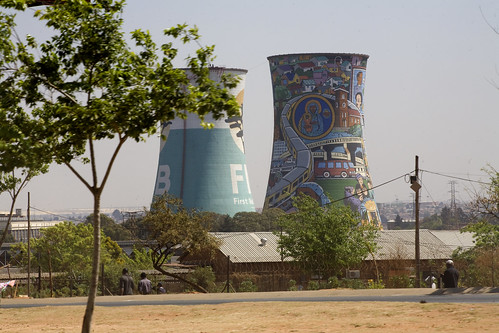
Across from this taxi rank is the largest Hospital in the southern hemisphere. The Chris Hani Bara Gwaranath Hospital provides public health care for the township and surrounding areas. It's named after Chris Hani the former president of the Communist Party who was assassinated by the apartheid regime in 1992. It sees an estimated one million patients a year and has an extensive facility that includes a large housing complex for the doctors who come from all over the world to work there.
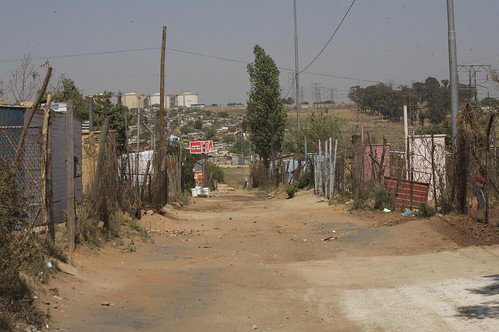
Just beyond the hospital and the old power station, we come upon an informal settlement and SonnyBoy pulls into a dirt lot where we will take a short tour inside. This is one of many informal settlements in the township. This one is named after Elias Motswaledi who was arrested with Nelson Mandela in 1963. Started in 1993, the lot where this settlement stands was once owned by a white farmer in response to growing unrest to the housing crisis. 10 million homes were planned to be completed in ten years starting in 1994 and only four million have been completed so far. Residents here have little faith this goal will be met.
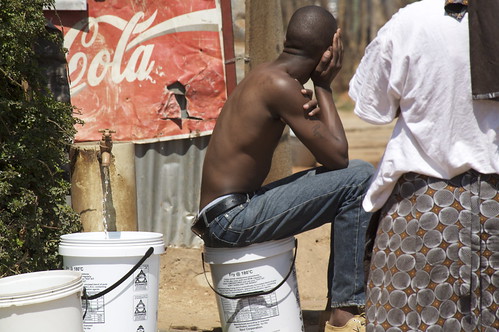
The government has done little to improve conditions here, there are 50 community water taps for the 1 250 spaces, no sewage, and no electricity. There are long drop toilets, simple holes in the ground, each serving two to three families each. Deficient infrastructure does not mean this settlement goes without regulation. Amazingly there are rules to qualify to live here; residents must make no more than 3 000 Rand a month. With rising food and fuel costs, almost 100% in the last three months, it seems almost against reason to put restrictions on those who are trying desperately to rise out poverty.
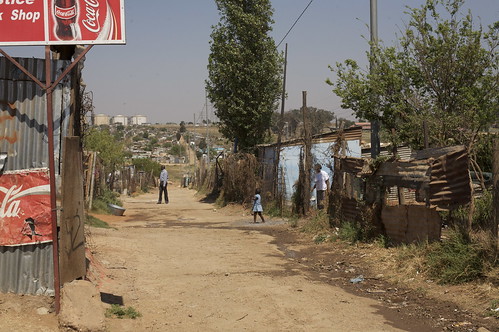
Roughly 20 000 people live here from 8 different tribes speaking as many languages. Xolisa, our resident guide, is university educated, articulate, and thoughtful. But he, like his neighbors in the settlement suffer from high unemployment, a lack of opportunities and ill-thought out government policy. Government grants for each child under 13 years of age have the expected result of increasing the burden on the community by encouraging more children.
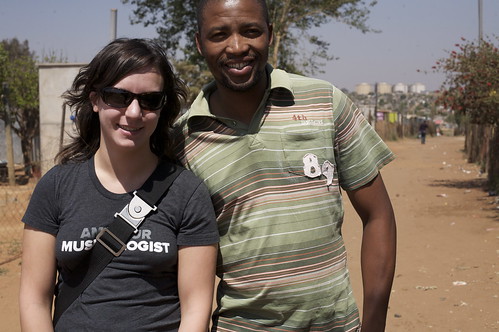
We visit the home of one of the residents, Hilda. She lives in a small single room shack. She cares for seven grand children, and at 67 is now too old to work. Our conversation lasted a few minutes, we got to ask a few questions and was asked to make a small cash donation that she immediately slid under her pillow, next to other donations from the tourists who visited her earlier in the day. She was convincingly pitiful and our short visit was among the most awkward interactions I've had with another human being in my life.
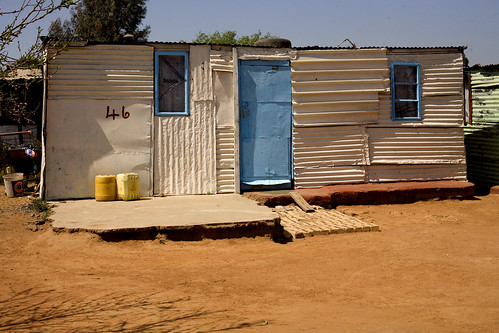
Her story was sad, but it was hard not to deny how manufactured an experience this was. Manufactured for a burgeoning tourist industry whose increasing numbers have become part of a new industry. On our way out we are given the chance to buy a souvenir. Jess and I are split up to maximize the opportunity. It also reduces our bargaining position and exposes us to a greater number of the settlement's residents. To say the least, it is an experience that is highly designed. And it works. Jess and I both end up purchasing souvenirs and making donations to the settlement. After about 15 minutes and 450 Rand, the both of us leave with tokens of our visit and an experience we won't soon forget.
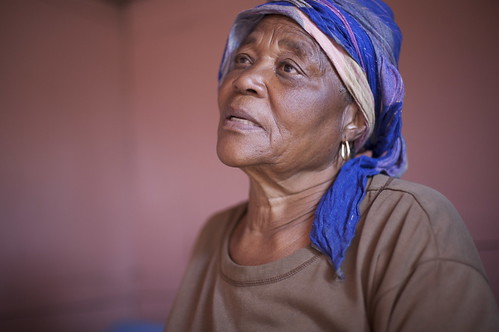
Friday, October 3, 2008
Unlikely Tourist in Soweto Part III

As we continue into the rest of Diepkloof one gets a better idea of how most of the township lives. Throughout the 1950's and 60's the government built "proper" houses for Soweto residents. These matchbox houses, so named for their minimal floor-plans, have proper running water, sewage systems, and electricity. Until 1994 these matchbox houses were available only as rented units from the government. Ownership was not only prohibited by law, but by the sheer economics of the township.

Many of the matchboxes have since been augmented with roughly constructed additions built with materials scavenged from construction sites or purchased from scrap yards. They now stand literally elbow to elbow with no easements. Many also have corrugated iron shacks in their yards, these aren't for storage, they are, incredibly, rental units for those who have come to Soweto from the countryside in search of better living conditions. Laughable by modern standards, these corrugated shacks represent income for many of Soweto's residents who otherwise have no marketable skills. Rents for these shacks can be as much as 150 Rand a month.

The occasional tuck shop, or convenience store, provide basics to the neighborhood as many of its residents cannot make the trek to markets that are car-distances away. Brightly colored public phone booths provide communication for the township. The woeful lack of a public transportation system is just another in a series of shortcomings that Soweto's residents must deal with. Black taxis, over-crowded mini busses, and make-shift horse carts are Soweto resident's only means of transport. The bicycle is conspicuously absent.

We leave Diepkloof and head to a nearby taxi rank, a depot for black taxis, where an informal market occupies a dirt lot. At the market entrance is a crudely erected tent; four unpainted steel poles and a dusty tarp provide shade for a make-shift table where the food is served. And it's served directly on the table next to tin cups, except for the rice, which would probably stick the the splinters of the raw wood top. The patrons welcome me to try the local fair with a chuckle. I'm adventurous, but not that brave.
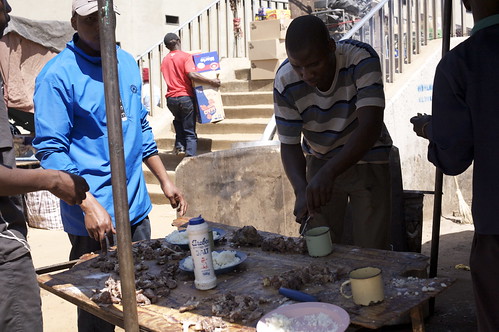

Aisles of stalls selling anything from produce to batteries comprise the market. Sellers break up large bulk purchases from the wholesale market across town, but not all sellers have managed the same scale. Some are selling individual candies and fruit for a few Rand a piece while others have larger operations. Everyone does what they can to eek out a living, trying to get enough Rand to have a single meal for the day.
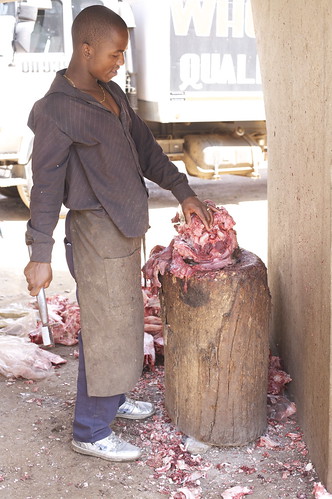
Wednesday, October 1, 2008
Unlikely Tourist in Soweto Part II
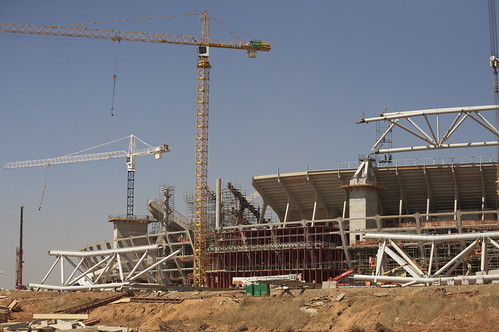
From the old city center it is not far to the site of the new stadium under construction for the 2010 FIFA World Cup. Its massive structural skeleton is still far from complete. With construction starting in 2006, the stadium is destined to host 120 000 fans for the upcoming World Cup. It stands as a symbol of progress, a display of progress and wealth. It also just happens to be located between the decaying city center and the township.
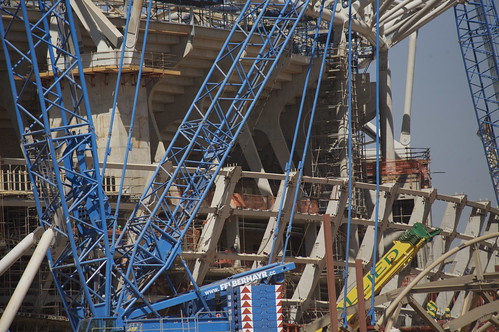
From the new stadium the vestiges of Soweto's past appear on the horizon. The cooling towers of the old power station, now painted to disguise their blighted appearance, stand as a reminder of a time where Johannesburg's energy was provided by the township at the expense of their environment. Pollution once spewed over the township while not a single volt of electricity was available to it. In 1970, they were finally shut down amidst criticism and growing dissatisfaction with the apartheid regime. It would be more than another 20 years until the township itself would see modern electrification.
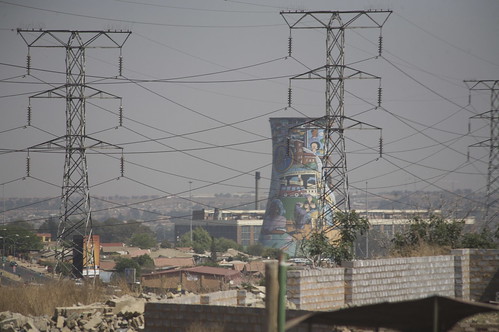
Our tour of Soweto proper started in the well-to-do neighborhood of Diepkloof. Clean streets are lined with large modern houses with varied architectural styles. Bed and breakfasts are scattered throughout this upscale neighborhood as tourism over recent years has become one of Soweto's new economic foundations. For relatively little Rand, a tourist can stay in the famous township overnight, something that many might have never imagined.
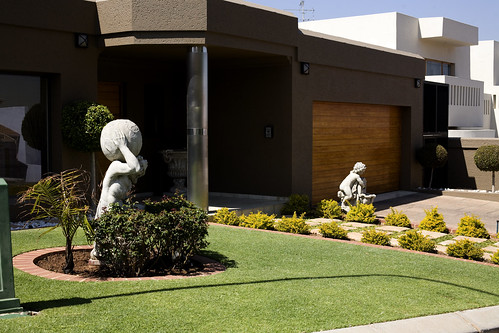
At the edge of Diepkloof Expensive, as SonnyBoy refers to it, we come upon a section of empty lots. From here aging hostels built in the 1960's by mining companies stand only a few hundred yards in the distance. These hostels once housed black workers migrating from the country side to work mining jobs in Joburg. They were male-only, had no running water or proper waste management and no electricity. They have since become residences for hundreds of squatting families.
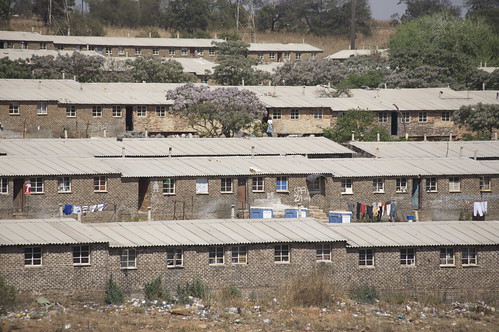
The government has taken steps to provide water taps and chemical porta potties, but have not electrified the units or installed proper sewage infrastructure. Rather they have begun the slow process of replacing these hostels with family housing units, still without electrical or sewage infrastructure, the units have yet to be populated by the families in the neighboring hostels. The resourceful residents have taken things into their own hands and have tapped illegally into the power grid by running raw non-insulated copper wire from light poles in Diepkloof across the street and into the hostels. If you don't know what you're looking for, these make-shift power lines are otherwise invisible except for the rocks that hold them down. Government and neighborhood officials have tried in vain to stop the practice.
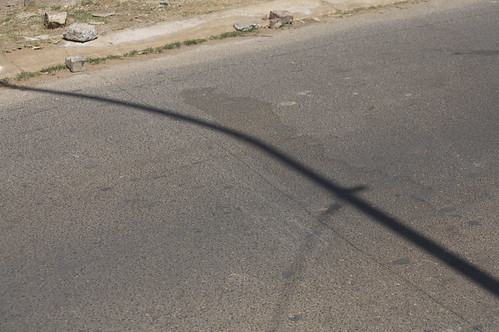
Subscribe to:
Posts (Atom)




